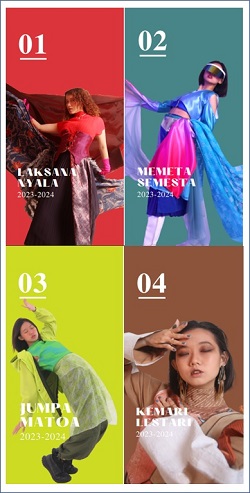Indonesia has a lot of cultural wealth that is used for the fashion industry. Different regions have traditional textiles with different motifs.
Professor of the Faculty of Cultural Sciences, University of Indonesia, Prof. Dr. Lilawati Kurnia, S.S., M.A., Friday (20/8) said that traditional Indonesian fabrics have the same potential economic value as tourism if they are taken seriously.
"So there are two parallel things to be advanced, because traditional motifs, kumo motifs must also be preserved. So, for example, to attract young consumers, but for world collectors, look for the traditional ones, the old ones," said Prof. Lilawati.
One of them, the Iban Dayak ikat weaving is one of the archipelago's heritage fabrics which is starting to become rare. Unfortunately, according to Prof. Lilawati, ikat cloth is mostly marketed in Malaysia and is better known there. There are also many world collectors who hunt these fabrics and buy them at a high price equivalent to the price of the collection.
He said, fabrics with ancient motifs and laden with areas of a place, need to be developed seriously. With serious cultivation, he believes that the economic potential is high. Including, building the welfare of craftsmen.
Lilawati believes that almost all Indonesians have at least one dress made from traditional fabrics. Most are also able to distinguish between batik cloth, woven or songket, however, not a few who do not understand which is the original fabric and the print. Therefore, education for consumers is very necessary
"What is important is educating consumers that handicrafts are expensive. If the craft takes a long time to make and is complicated, there must be a price, if general consumers want it cheap, they use asphalt woven (fake original) or metered cloth," he said. Prof. Lilawati.
Education about traditional fabrics and their development for the fashion industry must be carried out in collaboration with various fields such as tourism, industry and education. "The weavers are generally old, they should be included in the school curriculum in weaver areas, otherwise it will take a long time," said Lilawati.
National Chairman of the Indonesian Fashion Chamber (IFC) as well as a player in the Indonesian fashion industry, Ali Charisma agrees with high school. He said, to reach the international market, the design of clothing from traditional fabrics must follow global tastes or those of the world community, not only Indonesia.
Ali assessed, currently most of the fashion designs that use traditional fabrics are only for the country. In fact, designers can follow color trends and fashion styles abroad but use traditional motifs.
"Immediately work on traditional fabrics with a more global taste. Of course, the shape must be very simple, think of it like clothes in Indonesian malls, foreign brands everywhere can survive because the taste is global, so there is everything ," said Ali.
Lack of Competitivenes
Ali also said that most traditional fabrics usually have motifs that have been inherited by their ancestors. There's nothing wrong with this. However, to reach young people or wider consumers, new innovations are needed in terms of motif design and still maintain ancient motifs for high-end consumers or collectors.
"So I think it's different if the goal is to preserve culture by increasing the economy," he said.
He believes that ancient motifs will forever be sought after by high-end consumers and collectors. However, there is also a need for new innovations to make traditional fabrics fresher with different colors.
Ali hopes that there will be young people who have a passion for creating new motif designs that can be distributed to craftsmen so as to generate new selling points.
The textile industry or TPT itself is one of the most reliable sectors to absorb labor. Based on data from the Central Statistics Agency (BPS) managed by the Ministry of Industry, from year to year, labor absorption in this sector continues to increase, even in the midst of a pandemic situation.
In 2018 alone, there were 1.7 million workers in the textile sector. This figure rose to 2.8 million workers in 2019. In 2020, despite the pressure of the pandemic, labor absorption in the textile sector actually jumped to 3.9 million people.
In fact, Indonesia's TPT competitive ability is indeed lacking compared to some of the world's major producing countries. Secretary General of the Indonesian Textile Association or API, Rizal Tanzil Rakhman, said that this weak competitiveness was related to labor wages, raw materials, energy, infrastructure, interest rates, the environment.
"From these factors, almost all of us are not competitive compared to other countries. For example regarding wages, our average is still higher than other textile producing countries, such as China, India, Bangladesh, Vietnam," he explained.






